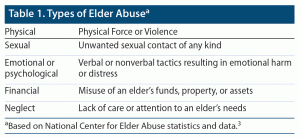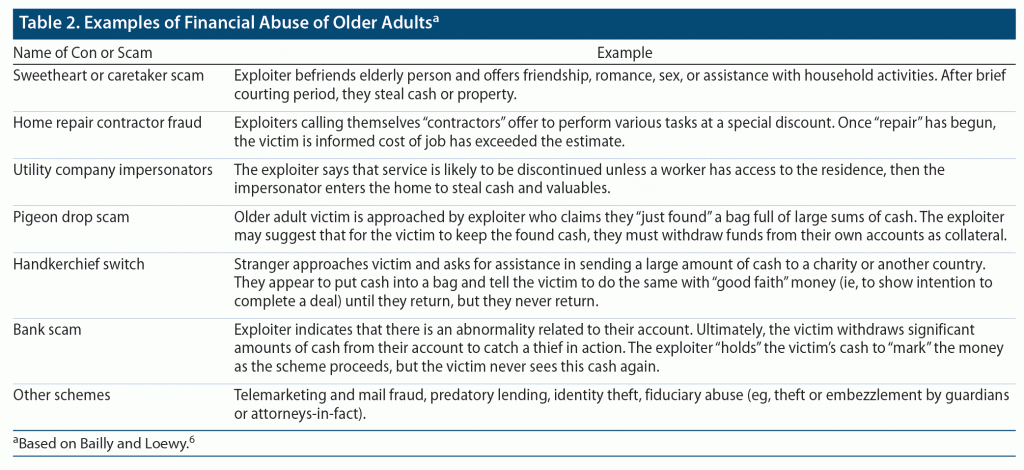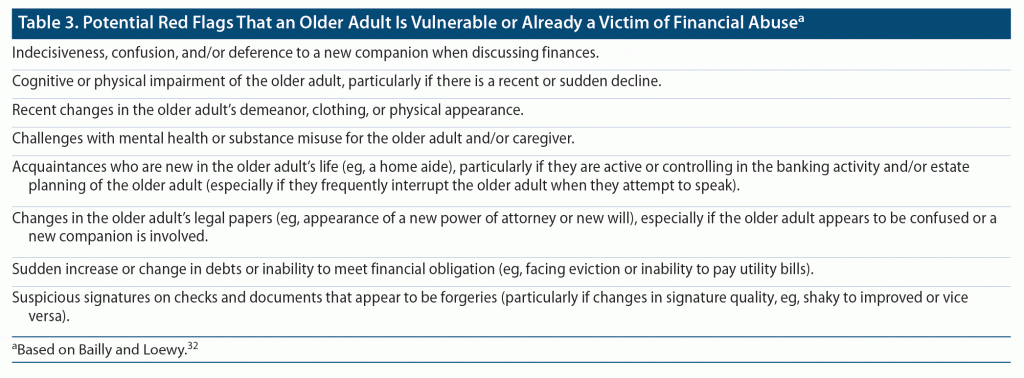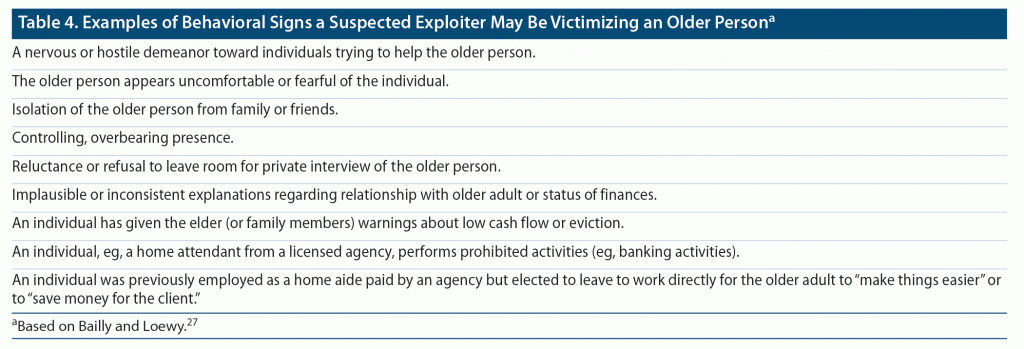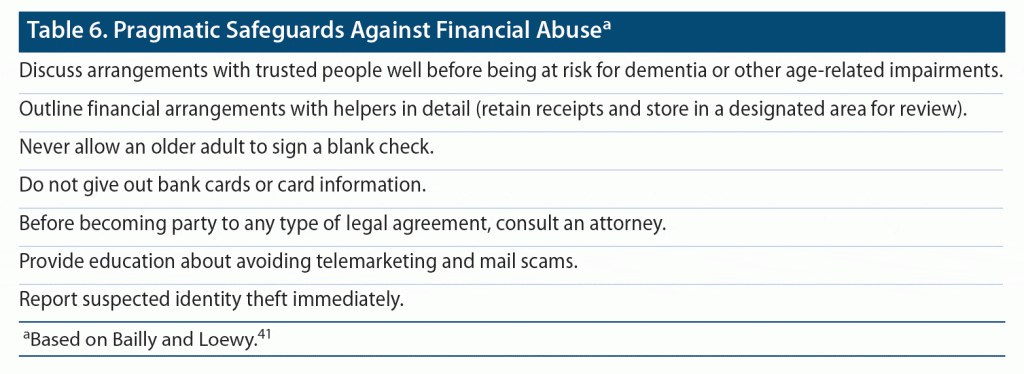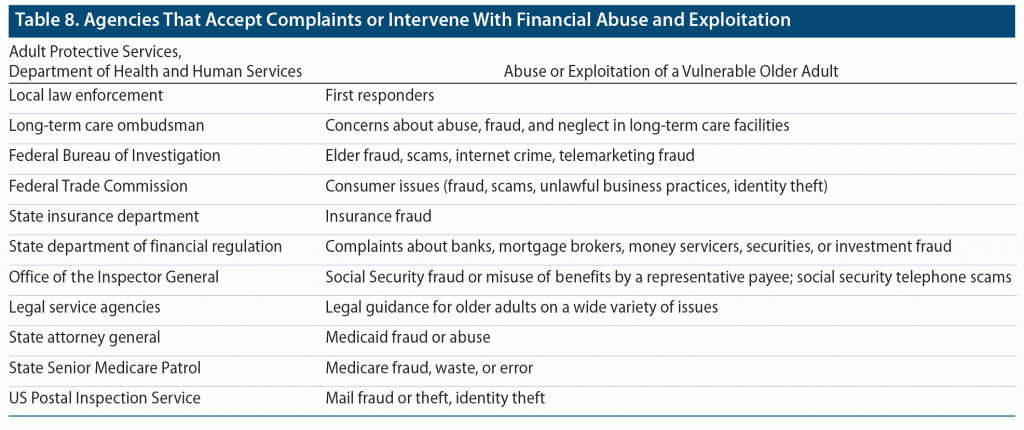LESSONS LEARNED AT THE INTERFACE OF MEDICINE AND PSYCHIATRY
The Psychiatric Consultation Service at Massachusetts General Hospital sees medical and surgical inpatients with comorbid psychiatric symptoms and conditions. During their twice-weekly rounds, Dr Stern and other members of the Consultation Service discuss diagnosis and management of hospitalized patients with complex medical or surgical problems who also demonstrate psychiatric symptoms or conditions. These discussions have given rise to rounds reports that will prove useful for clinicians practicing at the interface of medicine and psychiatry.
Prim Care Companion. 2023;25(3):22f03434
Author affiliations are listed at the end of this article.
Have you ever wondered which of your patients are at risk for succumbing to financial fraud and exploitation? Have you been uncertain about how you might screen for, prevent, and intervene when your patients are at risk for financial abuse? If you have, the following case vignette, historical overview, and discussion should prove useful.
CASE VIGNETTE (PART 1)
Mr A was a 67-year-old single man with long-standing mild cognitive impairment (MCI) following traumatic brain injuries (TBIs) sustained in a serious motor vehicle collision 50 years before the current presentation (precipitated by his drinking alcohol), after which he was in a coma for several weeks. The injuries left him with right-sided paralysis and speech/language difficulties, for which he received physical and speech rehabilitation. His medical record also indicated as many as 3 additional concussive events.
Mr A presented now to his primary care provider (PCP) accompanied by his sister who expressed worries about his financial decision-making and behaviors (although Mr A was not concerned). His medical history was also notable for bilateral sensorineural hearing loss. His psychiatric history included hoarding, anxiety, depression, and severe alcohol use disorder (AUD). Given the complexity of his history, a psychiatric evaluation was requested by the PCP.
What Is Elder Abuse and What Role Does Financial Exploitation Have in Elder Abuse?
Elder abuse is a complex public health problem that can be defined as “abuse, neglect, abandonment, or financial exploitation of an older individual by another person or entity who has a trust-based relationship with the older adult or any harm that occurs because an older person is targeted by a stranger based on their age or disability.”1 Abuse has myriad forms, including physical abuse, sexual abuse, emotional and psychological abuse, financial abuse or exploitation, or neglect.2 (Table 1 provides a list of different types of elder abuse.3)
Definitions of and terminology around elder abuse and exploitation are inconsistent among academic, legal, governmental, social service, and health care entities, as well as professional and advocacy organizations. Definitions also vary in their identification of the age of the elder, the nature of the relationship to the perpetrator (known vs stranger), the types of incidents included, and other factors.
We have chosen to use the broad term financial abuse used by the National Center for Elder Abuse and defined as “the illegal or improper use of an elder’s funds, property, or assets including, but not limited to, misusing or stealing an older person’s money or possessions, coercing or deceiving an older person into signing any document (eg, contracts or will), and the improper use of conservatorship, guardianship, or power of attorney.”3 This definition incorporates both fraud (intent to deceive and carry out a predatory act by a stranger) and exploitation (acts committed by a person already in a position of trust with an older individual).4
Financial abuse includes fraud schemes that may involve perpetrators assuming a victim role to solicit financial assistance, manipulating virtual relationships (eg, “catfishing” or “sweetheart scams”), or deceptively obtaining bank account information from vulnerable adults.5 Financial abuse also includes theft of money or property, sale of fraudulent financial products, reverse mortgage fraud, identity theft, and scams involving home improvement, lotteries and sweepstakes, debt collection, and imposter scams (Table 2).6 The MetLife study of elder financial abuse characterized 3 types of elder financial abuse: crimes of occasion (opportunity), desperation (typically a family member with a need for money), and predation (when trust is gained with the intention of exploiting the older adult later).7
What Is the Scope and Impact of Financial Abuse in the Elderly?
Financial abuse of elders is underreported.8 According to a meta-analysis (12 studies involving 41,711 individuals; minimum age cutoff of 50 years), 1 of 18 community-dwelling, cognitively intact older adults in the United States face financial scams annually.9 Given that fraudsters often target community-dwelling, cognitively impaired elders—who are excluded from the estimate above—the extent of potential victims must be substantially higher.9
The National Elder Mistreatment Study analyzed data from 5,777 respondents and reported that 5% of community-dwelling adults over the age of 60 reported current (ie, past year) financial abuse (eg, spent money without permission, forged signature, forced to sign documents) by a family member.10 Nonuse of social services and need for help with daily activities were uniquely associated with increased likelihood of financial mistreatment.10 A study of over 4,000 community-dwelling, cognitively intact older adults found that 58% of financial exploitation was perpetrated by family members (most often adult children, 25%), 17% by friends and neighbors, and 15% by home care aides.11
Financial abuse is linked to the loss of $2.9 billion dollars annually,7 although some sources estimate that it may be much higher.12 The impact can be devastating for both patients and their families. Considering that many older adults live on fixed incomes or retirement savings, an elder’s ability to afford necessities, to pay bills, or to continue living independently may be disrupted. Families may be called upon to take a greater role in care of a loved one who has been the victim of financial abuse, including paying the elder’s bills or managing their finances, assisting with obtaining medical care and other supports, securing or providing care and housing, and handling legal matters. In addition to financial losses, targeted elders may lose trust in others and jeopardize relationships,5 as well as develop complicated emotional responses (including guilt, depression, shame) and contemplate suicide.13 Family members are also at risk for relationship strife or loss, particularly if the abuser is another family member. Victims of elder abuse are more likely to be hospitalized or placed in a nursing home14 and to die prematurely from elder abuse and neglect.15 Moreover, mortality rates for victims of financial abuse are comparable to those of caregiver neglect, which has the highest mortality rate of all types of abuse.16
What Are the Barriers to Reporting Financial Abuse and to Seeking Assistance?
Financial abuse can coexist with other types of abuse, as perpetrators may use psychological tactics and/or physical or sexual violence to threaten or gain control of the elder.8 Since older adults face a variety of barriers to reporting and seeking help for elder abuse, victims often wait until the situation is dire or their safety is at imminent risk.17 They may fear the consequences of reporting (eg, institutionalization, retaliation, or abandonment) to themselves or to the perpetrator.17 Cultural differences18 or religious beliefs17 can also alter the perception of abuse and help-seeking behavior. Psychological barriers include embarrassment, fear, or a sense of responsibility for their abuse or exploitation, and victims may be hesitant to disclose the extent of their victimization.19 Moreover, victims of financial abuse may be dependent on their abuser for access to basic needs and functional assistance; in addition, there may be mutual, or “synergistic,” dependency between the abuser and the victim (ie, wherein both individuals manifest excessive dependency on one another),20 leaving the victim in a difficult position to take actionable steps. Elders may be unaware of programs and services that can help them, or they may have concerns about the cost of services, creating additional barriers to seeking help and accessing services.21
What Are Potential Predictors of Vulnerability to Elder Abuse (including financial abuse)?
Any patient can be victimized; however, older adults, relative to younger adults, have a greater reliance on family, friends, neighbors, and strangers, which makes them more susceptible to financial abuse and exploitation.22 Living in shared housing situations, especially in facilities with many household members, and being female are factors linked to greater incidence of elder abuse.14 Lesbian, gay, bisexual, and transgender older adults are also at higher risk of elder mistreatment due to discrimination, a history of victimization, greater reliance on friends and non-relative caregivers, and their health status.23 Those with a history of interpersonal trauma are more likely to experience repeat victimization in older adulthood.24 In one study, childhood sexual abuse was linked with twice the likelihood of becoming a victim of elder abuse.25 These are important considerations for a clinician, as signs of trauma can be mistaken for physical and mental health problems.26
Mental health or neuropsychiatric challenges (eg, confusion or memory deficit) that interfere with the ability of an older adult to understand finances or business transactions may create vulnerability and dependency on others (including opportunists). Lack of capacity can affect an older adult’s ability to answer questions from law enforcement and impact their competency to testify in court.27 Patients with neurocognitive and social cognitive deficits are especially vulnerable to financial exploitation and are less able to detect scams.28 Neurodegenerative disease, TBIs, psychiatric disorders, and exposure to substances and alcohol can alter how an older patient makes decisions about their assets by impairing their thought processes.13 More recently, COVID-19 infection has produced cognitive changes, including altered mental status, encephalopathy, psychosis, a neurodegenerative (dementia-like) syndrome, affective disorders, and strokes, although the long-term impacts and potential for heightened susceptibility to financial exploitation are unknown.29,30 Individuals suffering from depression may also be more vulnerable to financial scams.24
The problem of elder abuse involves more than patient vulnerability. Although perpetrator attributes and risk factors have not been as widely researched as have the characteristics of alleged victims, the following have been identified as potentially contributing to abusive and exploitative conduct toward an older adult: physical and mental health issues, substance use, dependency on the victim, inability to cope with life stressors or caregiver responsibilities, negative attitudes about older adults or the caregiving role, relationship problems, isolation, low social support, and early life victimization.31
What Is the Role of the Primary Care Provider in the Screening and Prevention of Financial Abuse?
The role of the primary care provider includes (1) psychoeducation about financial decision-making and financial abuse, (2) screening for existing abuse, (3) risk assessment, and (4) management of the abusive situation. Educating patients and caregivers as part of routine psychoeducation even before concerns are unearthed is an important means to combat financial abuse of the elderly. Patients can also be directed toward resources to learn about the common types of fraud and scams and their warning signs. The Consumer Financial Protection Bureau provides consumer education resources on their website (www.consumerfinance.gov/), including financial decision-making guides and guides for people managing others’ money. The Federal Deposit Insurance Corporation (FDIC) offers a “Money Smart” program for older adults (www.fdic.gov/resources/consumers/money-smart/index.html) using games and other resources to increase financial awareness and knowledge. Other educational resources are available through state and federal agencies (such as the Securities and Exchange Commission, the National Council on Aging, and State Agencies on Aging).
When concerns arise about a patient who is experiencing financial difficulties, it is often useful to delve more deeply into the situation and assess whether risk factors for financial abuse are present. Screening for vulnerability and for warning signs of financial abuse or exploitation is an important step. Warning signs include changes in the way the elder manages their money, unpaid bills, unexpected revisions in financial documents, the transfer or disappearance of monies, and eviction proceedings.14 Indicators that may be more evident to health care providers in office settings include signs of inadequate care, missed or cancelled appointments, failure to renew medications, lack of adherence to treatment plans, depression, anxiety, and malnutrition (with or without weight loss).14
During the patient interview, clinicians can tease out if the patient has been a victim of financial abuse or is at risk of becoming a victim (observations meriting concern are listed in Table 3).32 Useful starting points include assessing a patient’s anxiety level about their finances and learning whether they have a designated person with whom they discuss their finances.24 It is often helpful to ask directly if their money, credit cards, or bank cards have been used without their permission; if they have received phone calls asking them to wire or give money14; if they have enough money to pay for their essential needs; and if their care needs are being met.14,24 Table 4 provides examples of behavioral signs that indicate a suspected exploiter may be victimizing an older person.27
While a variety of screening tools for elder abuse exist, few focus specifically on financial abuse. The Lichtenberg Financial Decision Screening Scale (LFDSS)33 was created to provide a risk score based on 10 multiple choice financial decision-making items. Two conceptual frameworks, person-centeredness and decisional abilities, guided development of the LFDSS and supported the importance of assessing the older adult’s understanding of the financial decision in question. The LFDSS was found to be reliable and valid.34 Along with narrated online training and certification, the LFDSS became available (www.olderadultnestegg.com) and was renamed the Financial Decision Tracker (FDT). To demonstrate capacity to make a specific financial decision, an individual must be able to communicate 4 important elements of the decision: choice, understanding, appreciation, and reasoning. The FDT features questions that specifically address these elements (eg, What is the financial decision you are making? [choice]; What is the primary financial goal? [understanding]; How much risk is involved? [appreciation]; What is the purpose of your decision? [reasoning]).35 In addition, the FDT assesses the autonomy of the individual (eg, Was this your idea or did someone suggest it or accompany you? To what extent did you talk with anyone regarding this decision?).
Systematic reviews36,37 of screening tools caution that there is no perfect screening tool for elder abuse. Due to differences in variables used in research studies, comparison is difficult, and no studies have examined the potential negative effects of screening or impact of false positives.36 Screening tools should be chosen based on the setting and individual situation, the length of time available for screening, and with consideration for the method of administration (self-administered or direct questioning).37 Considering financial abuse often occurs in tandem with other types of abuse,8,14 screening for general elder abuse using a tool that includes questioning about financial abuse may be a prudent choice.
Screening for elder abuse by physicians may be enhanced by using supportive techniques. Evidence-based communication methods used to screen for interpersonal violence that may be useful when screening for financial abuse include talking with patients privately (ie, without a caregiver or other family member present), recognizing and acknowledging when an abuse disclosure is made, assessing safety properly, providing resources to the patient, and referring the patient to supportive services.38 Asking patients about abuse in a direct and respectful way, using open-ended and follow-up questions (eg, Does your caregiver depend on you for financial support or shelter? Has money been stolen from you?), validating a patient’s experience, and showing empathy when abuse is disclosed are important to support patient disclosures.38 Use of principles of trauma-informed care (eg, mirroring the language that the older adult uses, asking about their strengths and goals, and asking for permission before touching a patient) offers a person-centered approach.33 Physicians should also recognize that patient disclosures may unfold over time rather than during a single visit or with information gathered from a screening tool; this requires the development of trust with the patient and adequate time for discussing a patient’s concerns over the long term.39
CASE VIGNETTE CONTINUED (PART 2)
Mr A was evaluated by the psychiatric consultant. There was no history of suicide attempts or psychiatric hospitalization. There was no family history of psychiatric illness.
However, Mr A had a long history of behaviors consistent with cognitive impairment and AUD. These behaviors were well known to his PCP and to the local police department, as he frequently became disruptive when intoxicated. In addition, police had found him walking alone covered in the snow, presumably from repeatedly falling after drinking alcohol to excess.
Mr A’s sister attended the visit with him and provided collateral information that proved to be invaluable. His sister reported that he was exhibiting behaviors that were increasingly troubling to her as well as to his neighbors. While living in low-income housing for older adults, he hoarded useless items (eg, aluminum cans to redeem later to procure funds for financial scammers). He also routinely searched through dumpsters to find food, bottles, and cans and scavenged on private property.
Neighbors contacted the police on multiple occasions to complain about Mr A’s poor hygiene and rummaging through dumpsters. He met with his local housing authorities, who repeatedly warned him to stop hoarding cans, as neighbors had complained about the noise he created. These issues were alleged to be lease violations, and Mr A’s housing was in jeopardy.
Mr A’s sister also expressed significant concerns about his socioeconomic well-being, but, in contrast, Mr A stated he had no concerns about either his finances or his housing situation. Additionally, Mr A’s sister reported that he had been the victim of a variety of fraudulent telephonic and internet schemes (Table 5), resulting in the loss of more than $30,000 over a 10-year period. Mr A’s sister also reported that he would spend several hours each day communicating online with individuals about financial schemes. When asked about the financial schemes, Mr A became defensive and irritable. In view of his aberrant behaviors and cognitive impairment, the treatment team deliberated on possible interventions for Mr A.
What Is the Differential Diagnosis and Workup of Financial Abuse?
Given the intertwined nature of financial abuse and other types of abuse, it is important to look for other signs.14 Clinicians need to assess for any medical or neuropsychiatric/behavioral conditions (eg, Diogenes syndrome, a condition in which afflicted individuals often live in extreme squalor and exhibit syllogomania [ie, excessive hoarding of rubbish])40 that could impact the older adult’s physical or cognitive functioning and cause pain, infection, dehydration, delirium, or loss of hearing or vision. Patients should be screened for underlying mood disorders, such as anxiety and depression, as well as neurocognitive disorders that could enhance a patient’s vulnerability to abuse and exploitation. Another diagnostic consideration is ongoing substance use that could interfere with the patient’s ability to think critically. Other workup strategies include obtaining a blood alcohol level, a urine drug screen, levels of vitamin D, vitamin B12, and thyroid function, as well as a comprehensive metabolic panel and a complete blood count to evaluate for treatable conditions that could adversely impact a patient’s mood and cognition. Nutritional and functional status should be assessed, and the patient’s medication list should be reviewed. A thorough clinical history from the patient, including any history of trauma, abuse, or victimization, and any collateral information are imperative to assess for possible financial fraud or exploitation.
What Are Possible Management Strategies for Cases of Financial Abuse?
Treatment to improve an individual’s thought process or mood may enable patients to better apply their judgment in questionable situations or to enhance coping skills when entwined in complex abusive circumstances. If there is an underlying thought disorder, anxiety, or depression, clinicians can evaluate their patient’s presentation and work with them to find appropriate pharmacologic treatments or psychotherapeutic interventions. Utilization of antidepressants, anxiolytics, antipsychotics, and cognitive enhancers may facilitate improvement, depending on the patient’s symptoms. Integrated care models in primary care, which include multiple disciplines to help address psychosocial and mental health concerns, are growing and especially helpful for older adults with behavioral health concerns.
Primary care social workers can conduct a psychosocial assessment to obtain more information about patients and their circumstances, and they can work with patients to develop a safety plan. See Table 6 for pragmatic safeguards against financial abuse.41 Social workers can provide education and facilitate access to services (such as legal assistance, professional money management, mental health, housing, transportation, food access, in-home care and household services, and adaptive equipment), social supports (such as senior centers or adult day health care),21 and spiritual or cultural resources. Social workers can also assist patients to define their health care preferences and to complete advance directives. Physicians can perform or request (eg, psychiatric consultation) a formal capacity assessment to evaluate the patient’s financial decision-making capacity. If the patient is found to lack decision-making capacity, the treatment team (in collaboration with supportive family members, if available) may explore the suitability of formal safeguards against financial abuse (Table 7).41 When a multidisciplinary team is collaborating on treatment, social workers may often serve to help coordinate these resources to improve treatment.
Interventions in financial abuse are complex and require thoughtful balancing of patient autonomy and safety. Patients may need time to process the information being given to them or the reality of their financial abuse. Involvement of other disciplines and a multidisciplinary team (if available) may help to provide coordinated support and guidance to the patient as well as to the patient’s family. Health care providers are mandated reporters regarding concerns of abuse, neglect, or exploitation (including financial abuse). Clinicians should notify their local state adult protective services agency if the patient meets their state’s criteria for a vulnerable adult (typically a person over age 18 years with a mental, developmental, or physical disability that prevents them from being able to protect themselves from abuse) and should report suspected abuse even in the absence of concrete evidence. If the patient does not meet their state’s criteria for a vulnerable adult, it may be useful to involve social services so that other agencies may be notified. Adult protective agencies in some states offer resources or assistance to an individual even if they determine no abuse or neglect has taken place. See Table 8 for a list of agencies that accept complaints or intervene with financial abuse and exploitation.
CASE VIGNETTE CONTINUED (PART 3)
Mr A’s sister requested help from his PCP, psychiatrist, and social worker, as she grew increasingly concerned over his financial abuse. The PCP and the psychiatrist, as well as other members of the treatment team, collaborated regarding his care and scheduled regular appointments with him. Psychoeducation was repeatedly provided to the patient about financial scams.
The psychiatrist assessed Mr A for financial decision-making capacity and found that he had cognitive limitations resulting from his TBIs and heavy alcohol use. His Montreal Cognitive Assessment42 score was 22 out of 30, consistent with MCI (a normal score is ≥ 26), with deficits in retrieval of words, short-term memory, clock-drawing ability, verbal fluency, and tasks of attention. His thought process was tangential and concrete, and his insight and judgment were limited. The psychiatrist suspected a possible compulsive component to Mr A’s presentation, having observed him e-mailing suspected scammers during an appointment. The psychiatrist also appreciated that Mr A was having difficulty with aspects of reality testing and making a reasonable appraisal of obviously false or misleading material (ie, impairment of anomaly detection). Since Mr A did not meet criteria for voluntary or involuntary psychiatric hospitalization, and he was not a threat to his safety or to that of others, outpatient management was continued.
The psychiatrist met with Mr A frequently, and the social worker contacted his sister. After careful consideration, Mr A was deemed to lack financial decision-making capacity (as he was unable to demonstrate that he could understand, appreciate, reason, and express consistent choice in the context of financial decisions). He also lacked the capacity to care for himself, as evidenced by poor hygiene and hoarding behaviors that contributed to his unsanitary living conditions and possible lease violations that jeopardized his housing. Meanwhile, Mr A continued to be victimized by financial scams, became increasingly defensive about them, and was unable to distinguish scams from genuine interactions.
Consequently, a report was filed with the state’s adult protective services. Mr A identified his sister as his primary social support, and his sister applied to become his legal guardian. He was educated about limiting his internet usage given his vulnerability to financial scams and was counseled to adhere to the rules of his housing association to avoid eviction. Mr A’s sister was also provided with caregiver support.
Mr A was treated on an outpatient basis with low-dose risperidone (0.5 mg by mouth at night) for behavioral disturbance and obsessive thinking. Although atypical antipsychotics can increase the risk of cerebrovascular accidents and death in older adults with dementia (and metabolic side effects in all patients), the benefit of using them was deemed to outweigh the risk of treatment. He discontinued risperidone after a short trial, as Mr A’s sister reported it caused sedation without appreciable benefit. Mr A was also provided with case management services through his primary care team.
CONCLUSION
This case demonstrates some of the vulnerabilities common to older adults, the variety of possible financial scams, and the determination with which criminals can target vulnerable elders. Technological advances have created novel ways to perpetrate financial abuse, while the rapid aging of the population (the so-called “silver tsunami”) increases the number of potentially vulnerable individuals. Both patients and providers desire to preserve patients’ independence; this can on occasion inhibit full assessment of physical, emotional, social, and cognitive deficits that accompany aging, possibly depriving older adults of access to impactful treatments, protective measures, and support services that can stop further financial abuse or prevent it entirely. Patients may seek to avoid embarrassment or attention, disincentivizing victims from reporting financial abuse.43 Victims of financial abuse are not always faultless. This dynamic is exemplified by the case of an older adult (with no impairment of cognitive function) who took out a loan to pay an unpaid tax bill and signed over his home as collateral. He did not make the required loan payments and was facing eviction; however, it was discovered the individual was hoping a declaration of incompetence would render the past transfer void.43 Moreover, exploiters may have legitimate roles in the victim’s lives as caregivers or social supports, and many do not appear to be the personification of evil that might be expected.43
Both underprotection and overprotection of older adults can lead to harmful consequences. Underprotection of older adults can lead to gross financial abuse.35 However, overprotection can be equally as damaging, as many older adults have a strong desire to maintain autonomy and control. The US Preventive Services Task Force concluded that the current evidence is “insufficient to assess the balance of benefits and harms of screening for abuse and neglect in all older or vulnerable adults.”44 However, when the index of suspicion for vulnerability to financial abuse is high, clinicians can incorporate screening questions and tools to evaluate their patients for risk factors, follow up with communication skills to facilitate patient disclosures of abuse, and employ appropriate mitigating measures. Assessment for financial decision-making capacity and use of pharmacologic and psychotherapeutic treatments as part of a multidisciplinary approach can help clinicians protect their patients from financial abuse.
Article Information
Published Online: June 13, 2023. https://doi.org/10.4088/PCC.22f03434
© 2023 Physicians Postgraduate Press, Inc.
Submitted: October 19, 2022; accepted January 26, 2023.
To Cite: Singh BK, Rustad JK, McWilliams G, et al. Financial abuse of older adults: screening, prevention, and interventions by primary care providers. Prim Care Companion CNS Disord. 2023;25(3):22f03434.
Author Affiliations: Department of Psychiatry, Geisel School of Medicine at Dartmouth, Lebanon, New Hampshire (Singh, Rustad, McWilliams); Department of Mental Health and Behavioral Sciences, White River Junction VA Medical Center, White River Junction, Vermont (Rustad, McWilliams, Poole); Department of Psychiatry, Larner College of Medicine at the University of Vermont, Burlington (Rustad); Larner College of Medicine at the University of Vermont, Burlington (Gaston); Department of Psychiatry, Massachusetts General Hospital and Harvard Medical School, Boston, Massachusetts (Stern).
Corresponding Author: James K. Rustad, MD, Department of Psychiatry, Geisel School of Medicine at Dartmouth, Dartmouth-Hitchcock Medical Center, One Medical Center Drive, Lebanon, NH 03756 ([email protected]).
Author Contributions: Drs Singh, Rustad, McWilliams, and Gaston and Ms Poole are co-first authors.
Relevant Financial Relationships: Dr Stern has received royalties from Elsevier for editing textbooks on psychiatry. Drs Singh, Rustad, McWilliams, and Ms Poole report no relevant financial relationships relevant to the subject of this article.
Disclaimer: Drs Rustad, McWilliams, and Ms Poole are employed by the US Department of Veterans Affairs, but the opinions expressed in this presentation do not reflect those of the US Department of Veterans Affairs.
Funding/Support: None.
CLINICAL POINTS
- Financial abuse of older adults is widespread and underreported; when clinicians encounter victims of elder abuse, they may also detect other simultaneously occurring forms of abuse.
- Working together, a multidisciplinary health care team, social workers, local reporting agencies, and family members can provide coordinated, multifaceted support for the victim and can most effectively intervene.
- A combination of methods (when indicated) is best for effectively detecting financial abuse: development of a trusting clinical relationship and use of clinical interview techniques, general questions about a patient’s financial situation and independence, standardized screening tools for elder abuse, capacity assessments, cognitive screening, and collateral information.
- Providing access to support services (such as pharmacologic treatment, counseling, professional financial and/or legal services, in-home supports, community resources, and safety planning) are all possible interventions that may support vulnerable victims of financial abuse.
References (44)

- Connolly MT, Brandl B, Breckman R. Elder Justice Roadmap: A Stakeholder Initiative to Respond to an Emerging Health, Justice, Financial and Social Crisis. Department of Justice website. Accessed January 11, 2023. https://www.justice.gov/elderjustice/file/829266/download and https://www.justice.gov/file/852851/download
- National Center for Elder Abuse. Tools Inventory. NCEA website. Accessed January 11, 2023. https://ncea.acl.gov/Resources/Tools-Inventory.aspx
- National Center for Elder Abuse. Research Statistics and Data (acl.gov). NCEA website. Accessed January 11, 2023. https://ncea.acl.gov/About-Us/What-We-Do/Research/Statistics-and-Data.aspx
- DeLiema M. Elder fraud and financial exploitation: application of routine activity theory. Gerontologist. 2018;58(4):706–718. PubMed CrossRef
- Nguyen AL, Mosqueda L, Windisch N, et al. Perceived types, causes, and consequences of financial exploitation: narratives from older adults. J Gerontol B Psychol Sci Soc Sci. 2021;76(5):996–1004. PubMed CrossRef
- Bailly RM, Loewy E. Application of Criminal Law to Financial Exploitation. In: Bailly RM, Loewy E, Bomba MA, et al, eds. Financial Exploitation of the Elderly: Legal Issues, Prevention, Prosecution, Social Service Advocacy. Kingston, New Jersey: Civic Research Institute; 2007:3–9–3–18.
- The MetLife Study of Elder Financial Abuse: Crimes of Occasion, Desperation and Predation Against America’s Elders. National Committee for the Prevention of Elder Abuse (NCPEA), Virginia Tech, and MetLife Mature Market Institute. Justice.gov website. Accessed January 11, 2023. https://www.justice.gov/file/852731/download
- Knight BG, Kim S, Rastegar S, et al. Influences on the perception of elder financial abuse among older adults in Southern California. Int Psychogeriatr. 2016;28(1):163–169. PubMed CrossRef
- Burnes D, Henderson CR Jr, Sheppard C, et al. Prevalence of financial fraud and scams among older adults in the United States: a systematic review and meta-analysis. Am J Public Health. 2017;107(8):e13–e21. PubMed CrossRef
- Acierno R, Hernandez MA, Amstadter AB, et al. Prevalence and correlates of emotional, physical, sexual, and financial abuse and potential neglect in the United States: the National Elder Mistreatment Study. Am J Public Health. 2010;100(2):292–297. PubMed CrossRef
- Peterson JC, Burnes DP, Caccamise PL, et al. Financial exploitation of older adults: a population-based prevalence study. J Gen Intern Med. 2014;29(12):1615–1623. PubMed CrossRef
- Deane S. Elder Financial Exploitation: Why It Is a Concern, What Regulators Are Doing About It, and Looking Ahead. US Securities and Exchange Commission, Office of the Investor Advocate. Sec.gov website. Accessed January 11, 2023. https://www.sec.gov/files/elder-financial-exploitation.pdf
- Greene AJ. Elder financial abuse and electronic financial instruments: Present and future considerations for financial capacity assessments. Am J Geriatr Psychiatry. 2022;30(1):90–106. PubMed CrossRef
- Lachs MS, Pillemer KA. Elder abuse. N Engl J Med. 2015;373(20):1947–1956. PubMed CrossRef
- Yunus RM, Hairi NN, Choo WY. Consequences of elder abuse and neglect: a systematic review of observational studies. Trauma Violence Abuse. 2019;20(2):197–213. PubMed CrossRef
- Burnett J, Jackson SL, Sinha A, et al. Five-year all-cause mortality rates across five categories of substantiated elder abuse occurring in the community. J Elder Abuse Negl. 2016;28(2):59–75. PubMed CrossRef
- Fraga Dominguez S, Storey JE, Glorney E. Help-seeking behavior in victims of elder abuse: a systematic review. Trauma Violence Abuse. 2021;22(3):466–480. PubMed CrossRef
- Lee YS, Moon A, Gomez C. Elder mistreatment, culture, and help-seeking: a cross-cultural comparison of older Chinese and Korean immigrants. J Elder Abuse Negl. 2014;26(3):244–269. PubMed CrossRef
- Frolick LA, Barnes AMC. Elder Abuse, Neglect, and Crime. In: Frolik LA, Barnes AMC, eds. Elder Law: Cases and Materials. New Providence, NJ: LexisNexis; 2015.
- Bornstein RF. Synergistic dependencies in partner and elder abuse. Am Psychol. 2019;74(6):713–724. PubMed CrossRef
- Olomi JM, Wright NM, Hasche L, et al. After older adult maltreatment: service needs and barriers. J Gerontol Soc Work. 2019;62(7):749–761. PubMed CrossRef
- Li T, Fung HH. Age differences in trust: an investigation across 38 countries. J Gerontol B Psychol Sci Soc Sci. 2013;68(3):347–355. PubMed CrossRef
- Bloemen EM, Rosen T, LoFaso VM, et al. Lesbian, gay, bisexual, and transgender older adults’ experiences with elder abuse and neglect. J Am Geriatr Soc. 2019;67(11):2338–2345. PubMed CrossRef
- Lichtenberg PA, Sugarman MA, Paulson D, et al. Psychological and functional vulnerability predicts fraud cases in older adults: results of a longitudinal study. Clin Gerontol. 2016;39(1):48–63. PubMed CrossRef
- Kong J, Easton SD. Reexperiencing violence across the life course: histories of childhood maltreatment and elder abuse victimization. J Gerontol B Psychol Sci Soc Sci. 2018;00(suppl_1):1–5. PubMed CrossRef
- Ramsey-Klawsnik H, Miller E. Polyvictimization in later life: trauma-informed best practices. J Elder Abuse Negl. 2017;29(5):339–350. PubMed CrossRef
- Bailly RM, Loewy E. Financial Exploitation of the Elderly–Defining the Issue and Profiling the Parties. In: Bailly RM, Loewy E, Bomba MA, et al, eds. Financial Exploitation of the Elderly: Legal Issues, Prevention, Prosecution, Social Service Advocacy. Kingston, New Jersey: Civic Research Institute; 2007:1–1–1–8.
- Pinsker DM, McFarland K, Pachna NA. Exploitation in older adults: Social vulnerability and personal competence factors. J Appl Gerontol. 2009;29(6):740–761. CrossRef
- Fotuhi M, Mian A, Meysami S, et al. Neurobiology of COVID-19. J Alzheimers Dis. 2020;76(1):3–19. PubMed CrossRef
- Ellul MA, Benjamin L, Singh B, et al. Neurological associations of COVID-19. Lancet Neurol. 2020;19(9):767–783. PubMed CrossRef
- Storey JE. Risk factors for elder abuse and neglect: a review of the literature. Aggress Violent Behav. 2020;50:101339. CrossRef
- Bailly RM, Loewy E. Investigating Whether Financial Exploitation Has Occurred. In: Bailly RM, Loewy E, Bomba MA, et al, eds. Financial Exploitation of the Elderly: Legal Issues, Prevention, Prosecution, Social Service Advocacy. Kingston, New Jersey: Civic Research Institute; 2007:2–1–2–24.
- Lichtenberg PA, Tocco M, Campbell R, et al. Implementation of financial decision-making scales into statewide APS practice: the Michigan experience. J Elder Abuse Negl. 2021;33(1):33–46. PubMed CrossRef
- Lichtenberg PA, Teresi JA, Ocepek-Welikson K, et al. Reliability and validity of the Lichtenberg Financial Decision Screening Scale. Innov Aging. 2017;1(1):igx003. PubMed CrossRef
- Lichtenberg PA. The Intersection of Dementia, Financial Decision Making and Financial Exploitation. Nationalacademies.org website. Accessed January 17, 2023. https://www.nationalacademies.org/documents/embed/link/LF2255DA3DD1C41C0A42D3BEF0989ACAECE3053A6A9B/file/D8FF0CA59F28691AF9778B010880225B20D45727A869?noSaveAs=1
- Gallione C, Dal Molin A, Cristina FVB, et al. Screening tools for identification of elder abuse: a systematic review. J Clin Nurs. 2017;26(15-16):2154–2176. PubMed CrossRef
- McCarthy L, Campbell S, Penhale B. Elder abuse screening tools: a systematic review. J Adult Prot. 2017;19(6):368–379. CrossRef
- Rhodes KV, Frankel RM, Levinthal N, et al. “You’re not a victim of domestic violence, are you?” Provider-patient communication about domestic violence. Ann Intern Med. 2007;147(9):620–627. PubMed CrossRef
- Truong C, Burnes D, Alaggia R, et al. Disclosure among victims of elder abuse in healthcare settings: a missing piece in the overall effort toward detection. J Elder Abuse Negl. 2019;31(2):181–190. PubMed CrossRef
- Stern TA, Pallais JC, Scharf JM, et al. Found in feces: differential diagnosis, workup, and treatment. Prim Care Companion CNS Disord. 2012;14(3):PCC.12f01341. PubMed CrossRef
- Bailly RM, Loewy E. How the Elderly Can Avoid Financial Exploitation. In: Bailly RM, Loewy E, Bomba MA, et al, eds. Financial Exploitation of the Elderly: Legal Issues, Prevention, Prosecution, Social Service Advocacy. Kingston, New Jersey: Civic Research Institute; 2007:11–1–11–13.
- Nasreddine ZS, Phillips NA, Bédirian V, et al. The Montreal Cognitive Assessment, MoCA: a brief screening tool for mild cognitive impairment. J Am Geriatr Soc. 2005;53(4):695–699. PubMed CrossRef
- Lynch JJ. Mental Capacity and the Older Adult–A Psychiatrist’s Perspective. In: Bailly RM, Loewy E, Bomba MA, et al, eds. Financial Exploitation of the Elderly: Legal Issues, Prevention, Prosecution, Social Service Advocacy. Kingston, New Jersey: Civic Research Institute; 2007:10–1–10–23.
- US Preventive Services Task Force. Final Recommendation: Intimate Partner Violence, Elder Abuse, and Abuse of Vulnerable Adults: Screening. US Preventive Services Task Force website. Accessed January 15, 2023. https://uspreventiveservicestaskforce.org/uspstf/recommendation/intimate-partner-violence-and-abuse-of-elderly-and-vulnerable-adults-screening
Please sign in or purchase this PDF for $40.
Save
Cite
